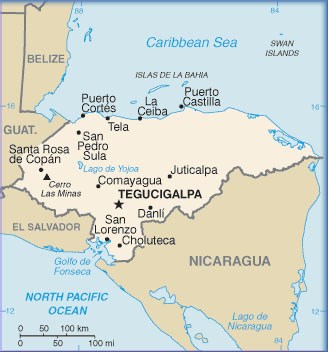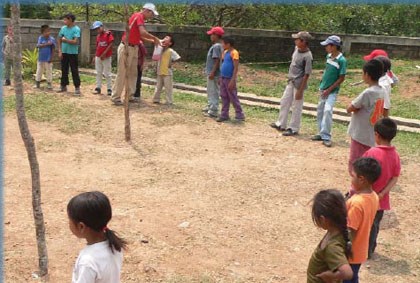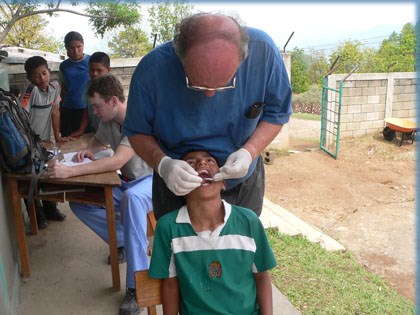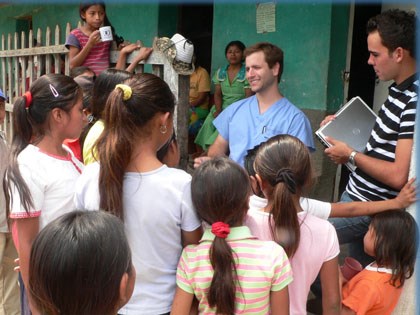Honduras - Oral Health Education and Care for a resource poor Honduran community
Honduras - Oral Health Education and Care for a resource poor Honduran community
Introduction
Few resources are available for the basic health and dental health needs of rural Hondurans. The Department of Family Medicine of the University of Rochester, New York, USA, in collaboration with the non-governmental organization called the Shoulder to Shoulder, operates an outreach programme to address these needs in a rural area of the country, since 2005 for the medical programme and 2006 for the dental programme.
The Shoulder to Shoulder Programme stresses in providing programmes with sustainable impact, thus participants work in primary health care roles and public health programmes and initiatives are central to the overall work.

Map from The World Factbook
Background
The clinic is situated in San Jose Centro, San Marcos de la Sierra, Departamento de Intibuca, Honduras. For the 4000 mixed indigenous community (Lenca), who live within a three hour walk from the clinic, the facility is the main source of medical and dental care. The clinic is also a global health training centre for young doctors and medical students. There is evidence that training in international settings during medical school and residency really increases the chance that these doctors will go on to practice in urban and rural needy areas and communities.
Most of the drinking water consumed comes from the natural springs, having fluoride concentrations of 0.08-1.8ppm.

The clinic Porch is actually dental clinic and registration area
Medical clinic and pharmacy are in another building
Project Outline
A baseline screening of 6-8 years old children in the San Jose school conducted in May 2006 revealed that over 83% had some dental caries at the time of examination. Occasional presence of fluorosis in the teeth, was observed in the community.

Flouride rinse
Conventional restorative care was not possible in this setting. The clinic was not connected to electricity till December 2007 and running water is still not available. A programme was conceived to suite the situation.
- Topical fluoride programme with 0.2% NaF rinsing, twice a week, five minutes for the rinse.
- A 5% fluoride varnish when possible, three applications within a two week period.
- School teachers, after receiving training, took on the responsibility for administering the fluoride (F) rinse.
- A prominent member of the community was the "keeper of F rinse", distributing the rinse to the teachers and community members involved.
- Dental and medical education was provided in the schools and the medical residents conducted informal patient education in the clinic waiting areas.
- As tooth brushes and pastes were unaffordable or not available to most children, cleaning the teeth using finger and salt was encouraged.
- During examination of school children in 2006, those with needs for dental services were referred to the clinic.
- As most of the parents were illiterate, parents could not read the letters of referrals, and so this was not followed up. Hence in 2007, a bright pink notice was given to the child, and parents were already informed about this in community meetings, which resulted in all most all the children referred, attending the clinic.
Achievements
One year into the programme, a second fluoride rinse programme was started in the nearby school.
In the first examination in May 2006, 83% of the 6-8 year old children had caries, after one year in May 2007, only 25% showed caries in this age group, and the 9-11 and 12 year olds too showed an improvement in the prevalence of caries in October 2007 (Table below).
A change in the kind of services was also noticed after 18 months with F rinse. Most referrals now were for growth and orthodontic related problems or ART restorations instead of extractions of untreated caries teeth.
Baseline and follow-up examination findings of the San Jose School
| Year | 6-8 years | 9-11 years | 12 years |
| May 2006 (baseline) |
17 children DMFS .12 83% with caries |
No examination | No examination |
| May 2007 | 20 children DMFS 0 25% with caries |
20 children DMFS 0.53 26% with caries |
23 children DMFS 1.95 31% with caries |
| October 2007 | 15 children DMFS 0 14% with caries | 18 children DMFS 0.7 18% with caries |
23 children DMFS 3.3 17% with caries |

Five-minute hold is important to achieve desired remineralization
Constraints
In October 2007, when the children were examined, it was revealed that there was a problem with the F rinse distribution. The teacher responsible for providing the F rinse was transferred to another school and the new teacher did not continue with the rinse programme. This resulted in some of the remineralized teeth showing caries activity. Fortunately the problem was discovered and rectified on time.

Schoolyard exams
Conclusion
This project has demonstrated that people with limited dental education, e.g. other members of the medical community and even parents and teachers, can contribute to dental health of their children and community working in conjunction with trained dental personnel. Dental Auxiliary personnel can be trained to carry out sealants, ART and oral hygiene services. The supervision of a dentist is necessary to prescribe the care and to diagnose the growth and development problems so common in these populations.

Medical resident conducting oral hygiene instruction
References
Carberry FJ, Phillips LE. Collaborative approach to dental care provision in resource poor Honduran community. N Y State Dent J 2009;75:34-38. Abstract PubMed
Acknowledgment
We thank the New York State Dental Journal for the illustrations used in this presentation
